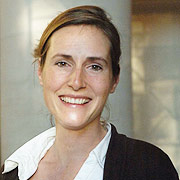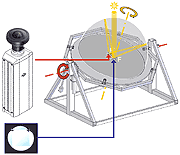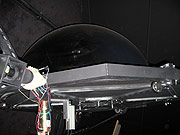Energy-efficient lighting: bringing daylight indoors
By combining a tilting platform, an acrylic dome, and a light source that mimics the sun, MIT researchers are creating a device that will help manufacturers design window systems that bring more daylight into buildings while controlling incoming solar radiation. The result should be significant energy savings and more contented occupants.
More than a third of the energy used in the United States is consumed in buildings, and 25 to 40 percent of that third is used to run electric lights. In many cases, daylight could be used instead. “Depending on the building and how it’s used, a good daylighting strategy can reduce the need for energy-consuming electric lighting by 20 to 80 percent,” said Professor Marilyne Andersen of the Department of Architecture.
The trick is to redirect incoming sunlight so that it, for example, bounces off a bright ceiling, bringing daylight farther into the room. Blocking the infrared component—the heat—or redirecting it to heat-retaining concrete structures in the ceiling can reduce the need for air conditioning and heat, adding to the energy savings.
Companies now make window coatings, solar blinds, and other systems that redirect or selectively filter incoming sunlight. “But for such products to be effective, building experts need to know exactly where the light rays go after they’ve passed through the coated glass or reflected off the blinds,” said Andersen. Getting it wrong can lead to glare and overheating. Down comes the shade, cutting out both daylight and the view of the passing day and changing weather—factors believed to improve productivity, well-being, and even health.
Determining how a piece of coated glass affects light seems simple. Just shine a light beam through it and use a light meter to measure intensity at various locations on the other side. But seeing how all the light is dispersed requires measuring at thousands of points—and still there are unmeasured spots in between. Moreover, since the sun moves and the brightness of the sky varies over time and space, the process must be repeated with the light source at different incident angles.
In the MIT HelioDome project, Andersen and her students are developing an innovative system that can measure the emerging light at every point, all at the same time—and then easily change the incident angle and repeat the process.
The MIT system
Key to their system is an ellipsoidal acrylic dome coated with a mirror on the inside. Placed on a flat surface, the dome (like all ellipses) has two focal points. A light ray shining upward from one focal point will bounce off the mirrored inside of the dome and return to the other focal point, regardless of the angle at which the ray leaves the first focal point.
To test a sample of, say, coated glass, they place it at one of the focal points. At the other focal point, a fish-eye lens protrudes from the flat surface. A beam of light (including the full solar spectrum) shines through the piece of coated glass from below, and rays emerge at various angles. They hit the mirrored dome at different locations, and then all bounce back to the fish-eye lens. With a sample that reflects, the light beam enters through the top of the dome onto the sample, and the reflecting rays bounce off the mirror to the lens.
Because the lens “sees” light coming in at all angles, the camera can take a digital photo of light reflected by the entire dome. Each pixel in the digital image corresponds to a single point on the dome, therefore to light leaving the sample at a single angle, and its intensity indicates how much light came via that pathway.
“So we get complete information in one image instead of making thousands of point measurements,” said Andersen. “It’s continuous information, and it’s obviously much more time efficient.”
Changing the incident angle of the light is also easy. The dome rests on a specially designed computer-controlled 5-foot-diameter platform that can tilt at various angles to the light source. (The platform is also proving ideal for seeing—for a given latitude and season—how sunlight illuminates and penetrates a scale model placed at its center.)
The researchers’ next task is to calibrate the system. They need to establish the relationship between pixel location and light angle and between intensity and light quantity. And they are developing analytical methods to determine the pathways taken by light of specific wavelengths—a prerequisite to controlling the heat component.
“Calibrating the device is very complicated, but we only have to do it once,” Andersen said. “After that, using the device to test samples will be very fast.” The data generated will help manufacturers improve their products and will enable Andersen and others to incorporate state-of-the-art window systems into building-simulation tools used by architects. The result will be better products used to their best effect.
—Nancy Stauffer
This research was supported by the National Science Foundation.




